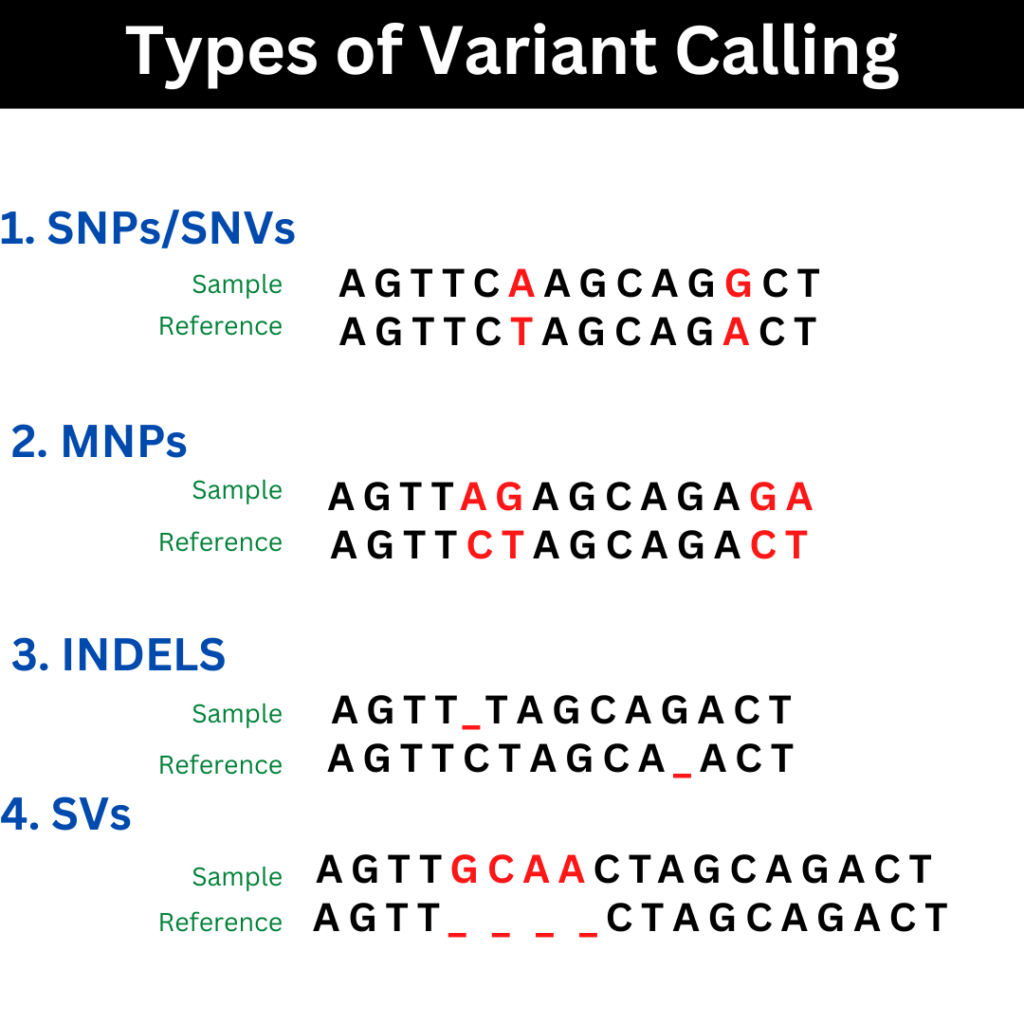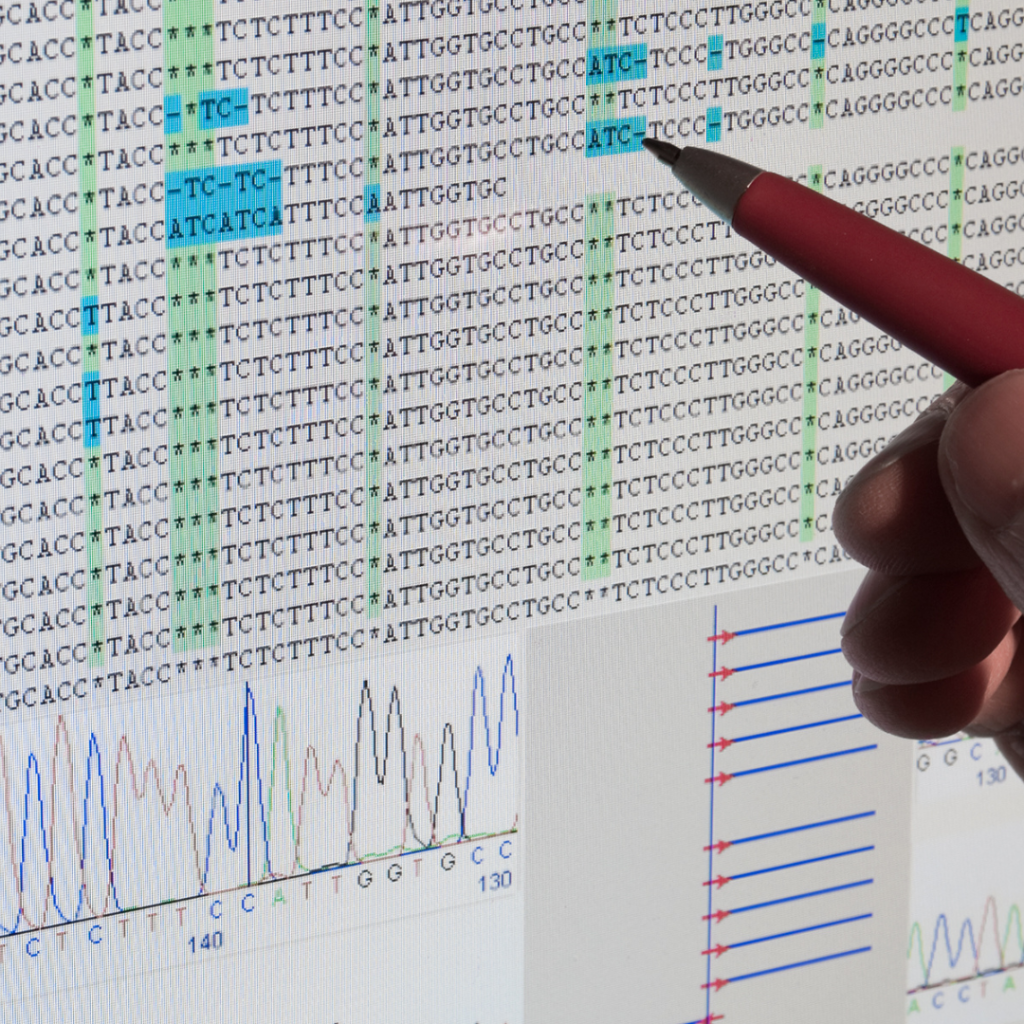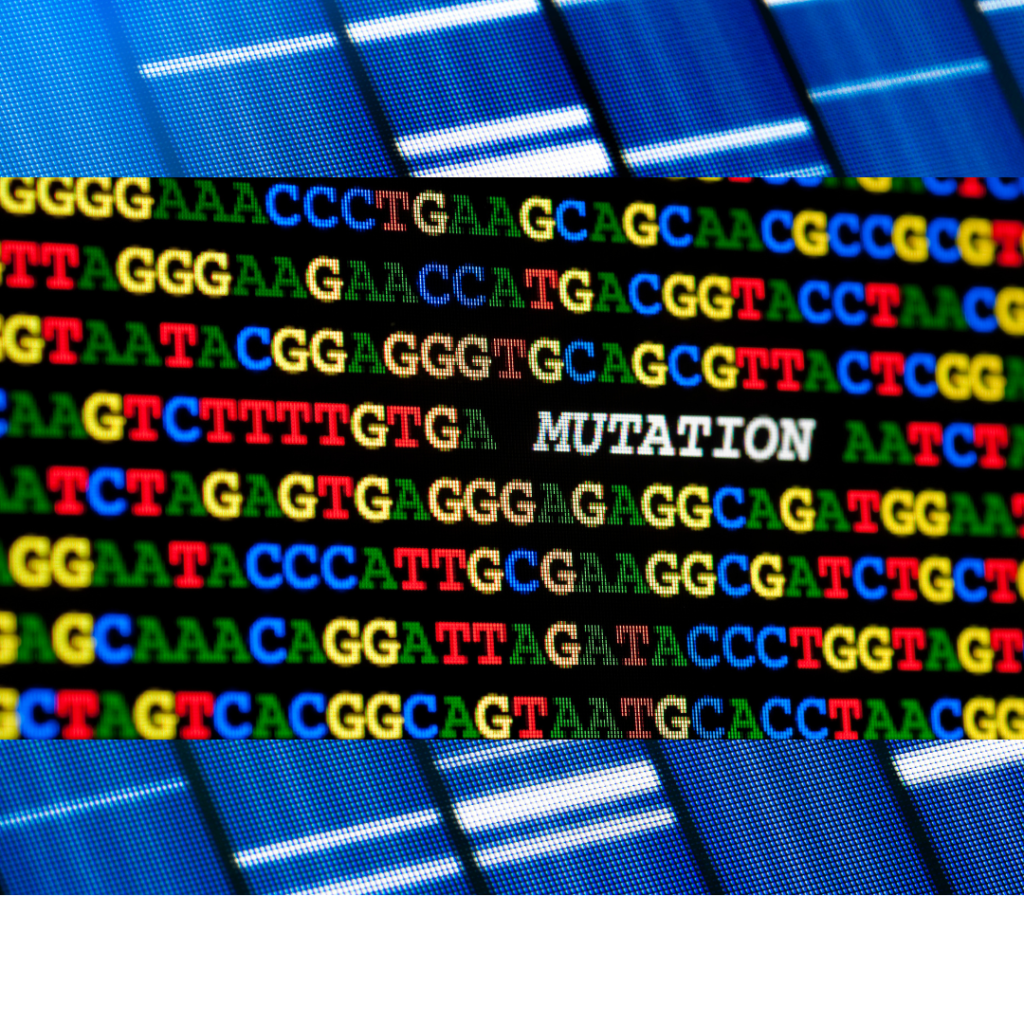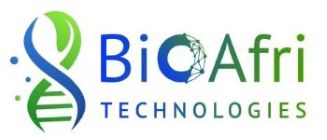Variant calling is the process of identifying differences between the reference genome and the samples that have been sequenced.
Experimental Procedure for NGS to generate reads
Due to the diversity of modern genomics protocols, methodologies, and platforms, there is no “one-size-fits-all” approach for study design and data analysis.
Here different forms of Variant Calling and how it is performed will be discussed. Also, the specific needs and fundamental principles governing their identification will be explained.
In scientific research, genome and exome sequencing techniques quickly replace genotyping microarrays. A fundamental advantage of emerging technology is its capacity to provide a nearly comprehensive digital image of the contents of our genomes.
Firstly, appropriate NGS experiments should have been performed through these pipelines to generate good reads (short or long). The reads should of high quality.
Library preparation
- DNA extraction
- Fragmentation
- Adapter ligation
- Amplification
Sequencing
- Base calling
- De-multiplexing
Genome coverage
The choice of sequencing strategy significantly impacts the average genome coverage depth. Short-read whole-genome sequencing is the most exhaustive method and often achieves 30 coverage, although long reads with inferior per-base quality are frequently sequenced to 60. Adequate coverage is a crucial component in variant calling.
Short and Long Reads in Variant Calling (VC)
In short reads sequencing, the average reads cover several hundred bases. Short-read is the most prevalent and cost-effective method for variant detection now. Since the cost is often proportional to the number of bases read, emphasis should be given to the longest possible reads and paired-end sequencing over single-end. VC will allow a more significant proportion of the genome to be explicitly addressed, increase the detection of structural variations, and enhance the efficacy of read-assembly approaches. In general, short read-based methods are well-established, inexpensive, and have low error rates. Still, they are unable to identify freshly replicated, repetitive sequences and under-represent DNA segments with a very high or low GC content. On the other hand, long readings can cover tens to hundreds of kilobases, which is helpful in calling more significant structural variations since they can span over huge repeats and GC-biased areas.

The Pipeline for Performing Variant Calling
The following procedures are followed to detect how a sequence is different (variant calling) with respect to the reference genome.
1. Data processing
- reference genome
- read mapping
2. Variant Calling and Analysis
- SNPs/SNVs
- MNPs
- Indels
- SVs
- Variant annotation
Data Processing
a. Reference genome
Choose a good reference genome of the specie in question from reference genome data banks. Always choose the latest or updated version of the genome. A poor choice of the reference assembly version can affect the results and thus should be carefully considered beforehand based on the aim of the study.
b. Read mapping/alignment
Utilize Genome Analysis ToolKit (GATK) to preprocess your data to eliminate many sources of data errors, such as amplification biases, sequencing errors, and base calling errors. At this juncture, it is advisable to prioritize sensitivity over specificity to avoid any potential variants. GATK pipeline employs a BWA-MEM aligner to map sequence data to a reference genome. BWA-MEM aligner is a robust mapping technique. GATK is a collection of tools that researchers could use quickly to complete the remaining preprocessing and variant calling procedures.
Variant Calling and Analysis
Calling variants is finding changes between the reference genome and sequenced samples. Variant calling could be single nucleotide polymorphism/variant (SNP/SNV), multi-nucleotide polymorphisms (MNPs), small insertions and deletions (INDELS), and structural variations (SVs), as shown below.

Variant calling: Single Nucleotide Polymorphism/Variation (SNP/SNV)
SNP/SNV refers to substituting a single nucleotide at a particular location in the genome and is the most common type of change observed in human genomes. In a typical genome sequencing project, millions of SNVs are identified per human sample.
In addition to the GATK, as mentioned above, various well-known applications, such as BCFtools and FreeBayes, may quickly generate a list of slight variants.
SNV summary characteristics can serve as metrics for quality control in population sequencing studies, which is quite intriguing. Consequently, a skewed ratio of transitions to transversions may indicate issues with SNV analysis or a solid mutational bias in the genome.
Insertions and deletions (indels)
Insertions and deletions (indels) occur when DNA is lost (deletion) or gained (insertion) on a scale of less than 1000 base pairs. If the indel occurs within a coding area, it is considered “in-frame” if the quantity of DNA lost or gained is divisible by 3; otherwise, it is referred to as a “frameshift” since the triplet reading code for all consecutive nucleotides is altered. Frameshift indels typically have a more significant functional impact than in-frame indels, as they frequently result in premature stop codons. Indels 40 bp are easily detected by sequencing technology. However, detecting indels >40 bp remains difficult. These modifications are shorter than a sequencing read and can be found by realigning partially mapped or unmapped reads with split-read aligners.
Multi-nucleotide polymorphisms (MNPs)
MNPs occur when two or more adjacent variations exist on the same haplotype in a person and are described as a collection of several dispersed SNPs within a genomic tract of fewer than 300 base pairs in length. Multinucleotide polymorphism is further classified into heterozygous MNP and homozygous MNP. In heterozygous MNP, one haplotype precisely matches the reference genome while the other differs at both places, but in homozygous MNP, both haplotypes deviate from the reference genome.
Structural variation (SV)
Structural variation (SV) is typically characterized as a 1000 bp or more significant stretch of DNA that may contain inversions, balanced translocations, or genomic imbalances (insertions and deletions), also known as copy number variants (CNVs). (SVs) are difficult to identify from brief readings. Typically, DNA variations that include many base pairs interfere with the mapping of reads that overlap them. These aberrant mapping signals represent structural discrepancies between the reference genome and the patient’s genome and can be utilized to find structural variants.

Variant filtering and annotation: Variant calling
Researchers utilize variant annotation to filter and prioritize functionally significant variants for further study. There are numerous popular tools available for variant annotation. Among them are:
- bcftools csq
- Ensembl VEP (Variant Effect Predictor)
- SnpEff
These instruments can be used to predict the functional impact of protein variations. (such as whether a variant causes missense, stop-gain, frameshift, etc.).
Variant calling for other data types
Due to the prevalence of sequencing techniques is also extensively used for profiling transcriptomes, epigenomes, regulatory proteins bound to DNA or RNA, etc. When calling variations, it is necessary to consider some significant distinctions between these data types.
Similar to exome sequencing, alternative data types do not necessarily have uniform coverage throughout the entire genome. Hence one cannot rely on the same completeness or detection power for variations from such data.
Moreover, variant calling software must pay particular attention to data set-specific characteristics. A good example is the typical occurrence of gapped alignment for splicing events in RNA-seq data. It is essential to prevent misalignment caused by the assignment of minor trailing portions of the read to an intron. Thus, transcriptome aligners have the capability for two-stage mapping: first identifying all novel splice junctions (ideally for all samples in the study) and then utilizing them in the second mapping stage to prevent misalignments and false SNPs. In addition, alignment gaps can complicate the process of variant finding; therefore, specific software solutions, like GATK, divide exonic blocks into many additional alignments to facilitate variant calling.

Non-genomic data
The second characteristic of non-genomic data is that some detected variants do not represent the DNA state but are introduced by technical or biological alterations. Such mechanisms include bisulfite conversion during methylation profiling and RNA editing. Although these alterations have a very distinct nucleotide context and substitution type, it can be challenging to distinguish them from true DNA variants with the same signature.
Last but not least, most data types do not necessarily represent both alleles equally. Differences in allele expression or haplotype-specific protein binding might tilt the allelic ratio away from the predicted 50%–50% in the genome or exome sequencing, making it more difficult to distinguish between actual variants and sequencing errors. In this situation, it may be advisable to validate variant findings, for instance, by comparing results to independent genotyping, such as SNP arrays, or by examining the consistency of calls among family members.
Conclusions: Variant calling
Recently, there has been an expansion of scientific research into new technologies. Despite the numerous constraints we face, there is a reason for optimism that they will be eliminated in the future, allowing researchers to collect a more comprehensive set of variants and devote more time to clinical and biological problems.









